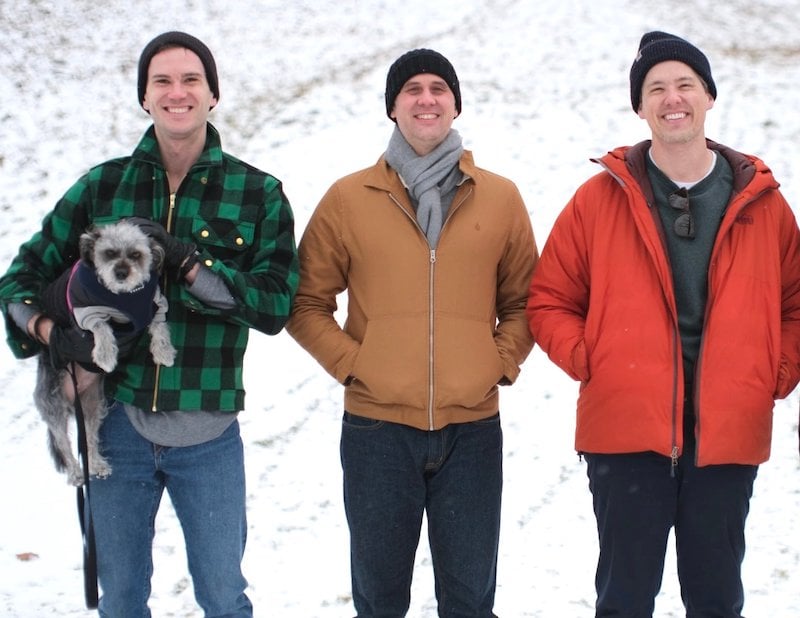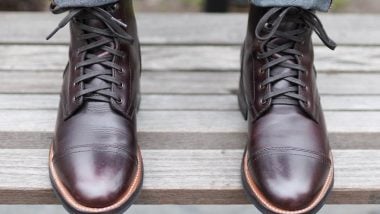How They Make Distressed Denim: Our Trip to a Jeans-Fading Factory
Everyone loves how faded jeans look but they also love how they feel. New and unwashed denim (that’s called raw denim) is stiff and rough, but it becomes wonderfully cozy after you put in just a year or two of wear and washes.
So it should come as no surprise that people have figured out how to treat raw denim to look and act like it’s been worn for years before you buy them. Pre distressed jeans have more texture and are more comfortable, plus they have that instant gratification element of giving you your end goal on day one.
If you’re apprehensive about buying a pair, I get it. I avoided “pre-faded” for years, and I run a denim blog. There was a whole world of washes I was closing myself off to.
But much like stretch denim, there’s a reason pre-distressed jeans are the more popular version, and I became a fan after the denim wizards at Hiroshi Kato showed me the surprisingly complex way they create their well-loved look.
It involves an element that’ll make you think of bananas. Watch it now!
Via an intricate 5-step washing process with enzymes, stones, and minerals, Kato's lovingly faded jeans make new denim look well-loved.
Further Reading

Best Selvedge Denim: 9 Solid Brands Expert Tested for Quality, Value, & Weirdness
I’ve accumlated quite the denim collection to find the best ones on the market. Learn more →

Stage 1: Hand Sanding and Distressing
- Mimics natural folding, creasing, walking, and rubbing
First you mimic lots of wear, then you mimic lots of washing.
The first step is more low-tech than you might have thought: Hiroshi Kato’s workers rub the jeans with sandpaper-like material, each with different levels of grit for different areas of the jeans.

When you sit, the fabric on the crotch bunches, and you eventually get the horizontal lines at the top of the thighs called “whiskers.” Over time, sitting and standing also puts more wear on the butt and upper thighs than the calves. And while you might not notice yourself doing it, we regularly rub or rest our hands on the top of our thighs.
All of these areas are abraded by hand to imitate all that wear.
“When they do the thighs, that’s when they put it up in the balloon,” Kato’s Wash Developer Daniel Cervantes explained as I watched the jeans get “worn” by butt-and-leg shaped balloons. “[The jeans] need to be stretched out because if they aren’t, then you’d get little creases in the fades, and it wouldn’t be consistent.”

Stage 2: Pocket Distressing
- Mimics the wear that pockets develop from years of use
Attention to detail is key to making a factory fade look like a natural fade. It’s kind of like the uncanny valley with CGI in movies: if you subconsciously miss some subtle detail, the wear and tear just won’t look right.
One of those subtle details is the fraying around the pockets that develops from years of putting your hands and belongings in and out of them. Hiroshi Kato mimics this by hand sanding the tops of the pockets with a tool called a dremel.

Stage 3: Washing
Now the jeans look alike they’ve been worn but never washed, so you need them to look lighter. But you can’t just make jeans with fabric that has less indigo in it; it has to look like it’s been washed from raw to faded, and that’s exactly what they do.
Just in a much shorter time period.
Pre-Wash
- ~ 20 minutes
- Removes sulfur, resin, and starch
- Dispersants added to pull out color
- Lubricants added to soften fabric
“The very first step is a pre-wash, which takes about 20 minutes,” says Daniel. “And what that does is it softens the fabric and gets it ready for the next step.”
It’s not just washed with water, nor do they add laundry detergent like you would. They need to replicate dozens of washes.
“We use dispersants to remove some of the chemicals that are already on the fabric, such as sulfur, resin, or starch,” says Director of Production Ricardo Cerventes.
The dispersant helps to pull out more color than a regular wash would, and it disperses the indigo in such a way that it won’t easily re-dye the jeans. As Daniel puts it:
“We have a lot of indigo, [and] the dispersant keeps the indigo from going back to the jeans.”

“The other chemical that we use [in the pre wash] is lubricant,” he adds. “That prevents the garment from breaking or getting creases.“
“It’s not really oil,” says Ricardo. “But it’s a kind of oily substance thattarts making the fabric soft to prepare it for the stone wash.”

Stone Washing
- ~35 minutes
- Gives a worn-in look and feel
- Pumice stones added to water to soften and abrade the fabric
- Enzymes added to speed abrasion without damaging the thread
If you were born in the 80s, you’ve endured at least one trend of stone washed jeans. The look that comes to mind is probably a distinctive one because jeans marketed as “stone washed” have, well, received a massive amount of stone washing.
But in fact, almost all pre-distressed denim gets a little stone washing to add elements of wear to the entire garment. After all, it’s not just the seat and the “whisker” areas that endure your daily life.

“Stone washing breaks it down and gives you a nice vintage look,” says Daniel. “These pumice stones get reused and reused until they just disappear. We reuse them as many times as we can; they end up like little pellets. And we even reuse that, so we really don’t waste anything.”
Meanwhile, enzymes are added to the water to help speed up the abrasion without damaging the thread too much; you want jeans that are distressed, but not worn out.
Via an intricate 5-step washing process with enzymes, stones, and minerals, Kato's lovingly faded jeans make new denim look well-loved.

Bleach Wash with Chlorine
- Lightens & brightens the blue
- Not always used; it depends on the desired color
“If you want it lighter, that’s when we add the chlorine to make it a nice, light, blue shade,” says Daniel.
You’ve probably noticed that not all pre-faded jeans look the same; even this one brand, Hiroshi Kato, has over a dozen different models of faded (sometimes called “washed”) blue jeans.
Some don’t get as many washes as others but if you like a lighter, brighter blue, your jeans have probably undergone a chlorine wash like this.

Potassium Spray
- Whitens the thighs
- Further mimics fading from wear and abrasion (rather than washing)
- Removes a little more color and softens the fabric
Potassium spray might sound like something you’d add to a banana milkshake — yes, it’s the same nutrient that hydrates you and helps your muscles function — but at Hiroshi Kato it’s used to whiten the thighs so it looks like you sometimes rest your hands or wipe them off there.
Again, not every faded jean gets this treatment, but it’s often used on higher contrast washes. In this instance it’s Kato’s “Julian” wash.
Final Wash
- Neutralizes/removes lingering chemicals that might be irritants
- Lubricants and silicone added to soften fabric
Whether or not the jeans have received a potassium spray, it gets a final wash to neutralize and/or remove any remaining chemicals. Yep, this is the fifth wash that some extra light jeans receive.
“We want to make sure to clean the garment really well and make sure we don’t leave any chemicals on it,” says Ricardo. “We don’t want people to wear it and get some kind of rash or chemical reaction.”
The final wash will also contain lubricants and silicone to make the fabric soft.
You might have noticed that almost every step of the wash process includes something to soften the fabric. Like we said: old jeans aren’t just faded, they’re softer and more comfortable, and this process has your comfort in mind just as much as the aesthetic.
Fading Jeans with Lasers
- An alternative (or supplement) to the “traditional” hand sanding and washing process
- Less effective at truly mimicking worn jeans, particularly with regard to softness
- But it’s faster and uses less labor, water, and chemicals
Another method for pre-fading jeans is using lasers, which is undeniably cool and a lot of fun to watch.
It has upsides and downsides. The upsides are numerous: it uses less labor, water, chemicals, time, and energy.
“If we’re not using potassium spray, we’ll sometimes need to laser the jeans twice to achieve a comparable look,” says Ricardo. “And sometimes we’ll combine the laser with washing techniques. In the future, it’ll probably be our goal to eliminate the potassium spray and incorporate laser instead. But it doesn’t look quite the same.”
Via an intricate 5-step washing process with enzymes, stones, and minerals, Kato's lovingly faded jeans make new denim look well-loved.
The Brand: Hiroshi Kato
This isn’t a sponsored article or anything, but you might be wondering why I went to Hiroshi Kato, of all brands. They’re unique in the world of denim for two reasons:
- The denim is selvedge
- The denim has four-way stretch
I’ll quickly break down why this has earned them a strong following.
What’s Selvedge Denim, Though?
Since the mid-20th century, almost all denim on Earth has been made on projectile looms. Before that, it was made on shuttle looms, which made denim ten times more slowly. If it’s called selvedge denim, it’s been made the old fashioned way. (We get into more detail in this selvedge denim explainer.)
Selvedge denim tends to be thicker and more complex than standard mall brands, though this doesn’t have to be the case. You can make perfectly boring denim on a shuttle loom, but customers who seek out selvedge tend to like interesting and unique jeans, so selvedge brands are known for experimenting with heavy and unusual fabrics, like yarn dyed with persimmon juice.
What’s 4-Way Stretch?
Like a lot of fabrics, denim is made with yarns woven in two directions: the warp runs vertically, the weft horizontally.
If a fabric has an element of stretch in it, then it’s been combined with something like elastane (or spandex or polyurethane, which are more or less the same).
With most stretch fabrics that aren’t athletic wear, you get either the warp yarn or the weft yarn imbued with that “stretch” property. If both the warp and weft have stretch then it has four-way stretch, and it’s considered more comfortable because it stretches in all directions.
Hiroshi Kato is the only brand that makes denim that’s both selvedge (woven on shuttle looms) and four-way stretch (stretches both vertically and horizontally).
But what we’ve shown you today is how any brand can make distressed jeans out of any old denim, stretchy-selvedge or regular.

Conclusion
I’ve always wondered if guys in denim factories are thrashing jeans with whips and stones to get them pre-distressed, and it turned out that wasn’t all that far from the truth!
The takeaway is that you don’t drop a pair of raw denim on a conveyor belt and pick up a ready-to-wear distressed pair on the other side. It really is an involved, hands on, and highly scientific process that combines modern technology and manual grit.
Understanding these processes definitely gave me a greater appreciation for this kind of product. In fact, since pre-faded jeans require more labor to produce than raw… maybe you could decide that this makes pre-faded jeans more valuable!











Join the Discussion